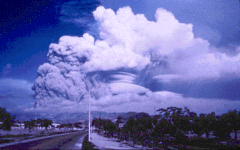Mount Pinatubo
| Mount Pinatubo | |
|---|---|

The eruption column of Mount Pinatubo on June 12, 1991, three days before the climactic eruption.
|
|
| Highest point | |
| Elevation | 1,486 m (4,875 ft) (current) 1,745 m (5,725 ft) (before 1991 eruption) |
| Listing | Active volcano |
| Coordinates | 15°08′30″N 120°21′00″E / 15.14167°N 120.35000°ECoordinates: 15°08′30″N 120°21′00″E / 15.14167°N 120.35000°E |
| Naming | |
| Pronunciation | /ˌpiːnəˈtuːboʊ/ |
| Geography | |
| Location | Luzon |
| Country | Philippines |
| Region | Central Luzon |
| Provinces | |
| Parent range | Zambales Mountains |
| Geology | |
| Age of rock | Between 635,000 ± 80,000 and 1.1 ± 0.09 million years |
| Mountain type | Stratovolcano |
| Last eruption | 1993 |
| 1991 Mount Pinatubo eruption | |
|---|---|

The eruption cloud shortly before the climactic eruption.
|
|
| Date | June 15, 1991 |
| Type | Ultra-Plinian |
| Location | Central Luzon Region, Luzon, Philippines |
| VEI | 6 |
| Impact |
|
Mount Pinatubo (Kapampangan: Bunduk a Pinatubu / Bunduk nang Apung Maliari; Tagalog: Bundok Pinatubo / Bulkang Pinatubo) is an active stratovolcano in the Cabusilan Mountains on the island of Luzon, near the tripoint of the Philippine provinces of Zambales, Tarlac and Pampanga. Its eruptive history was unknown to most before the volcanic activities of 1991. Pinatubo was heavily eroded, inconspicuous, and obscured from view. It was covered with dense forest which supported a population of several thousand indigenous Aetas people.
The volcano's Plinian / Ultra-Plinian eruption on June 15, 1991 produced the second largest terrestrial eruption of the 20th century after the 1912 eruption of Novarupta in the Alaska Peninsula. Complicating the eruption was the arrival of Typhoon Yunya (Diding), bringing a lethal mix of ash and rain to areas surrounding the volcano. Predictions at the onset of the climactic eruption led to the evacuation of tens of thousands of people from the surrounding areas, saving many lives. Surrounding areas were severely damaged by pyroclastic flows, ash deposits, and, subsequently, by the lahars caused by rainwaters re-mobilizing earlier volcanic deposits. This caused extensive destruction to infrastructure and changed river systems for years after the eruption.
The effects of the eruption were felt worldwide. It ejected roughly 10,000,000,000 tonnes (1.1×1010short tons) or 10 km3 (2.4 cu mi) of magma, and 20,000,000 tonnes (22,000,000 short tons) SO
2, bringing vast quantities of minerals and metals to the surface environment. It injected more particulate into the stratosphere than any eruption since Krakatoa in 1883. Over the following months, the aerosols formed a global layer of sulfuric acid haze. Global temperatures dropped by about 0.5 °C (0.9 °F) in the years 1991–93, and ozone depletion temporarily increased substantially.
...
Wikipedia

